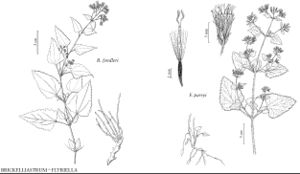Brickelliastrum
Phytologia 24: 63. 1972.
| Taxon | Illustrator ⠉ | |
|---|---|---|
 | Brickelliastrum fendleri Flyriella parryi | Linny Heagy Linny Heagy |
Perennials or subshrubs, 30–80+ cm (plants not viscid). Stems decumbent to erect, much branched from bases. Leaves cauline; mostly opposite (distal sometimes alternate); petiolate; blades usually 3-nerved, deltate to ovate, margins crenate-dentate, faces pubescent or glabrous, sometimes glanddotted. Heads discoid, in loose, corymbiform to paniculiform arrays. Involucres ± campanulate, 4–7 mm diam. Phyllaries persistent, 20–25 in 3–4 series, 2-nerved or 4-nerved, lanceovate to lanceolate, unequal (herbaceous to chartaceous). Receptacles convex, epaleate. Florets 25–35; corollas white or yellowish white, throats funnelform (lengths 2.5–4 times diams.); styles: bases not enlarged, glabrous, branches narrowly clavate. Cypselae prismatic, 5 (–7) -ribbed, puberulent; pappi readily falling or fragile, of ca. 25 barbellate bristles in 1 series. x = 10.
Distribution
sw United States, n Mexico
Discussion
Species 2 (1 in the flora).
B. L. Turner (1988c, 1994c, 1996+) placed Brickelliastrum, Asanthus, and the Mexican genus Dyscritogyne R. M. King & H. Robinson within Steviopsis R. M. King & H. Robinson. All four are essentially segregates of Brickellia, distinguished especially by their lack of pubescent swellings at bases of stylar shafts. As noted by Turner, this aggregate forms a heterogeneous group; the finer division is followed here until further evidence indicates a better taxonomic disposition.
Selected References
None.
Lower Taxa
"fine" is not a number.